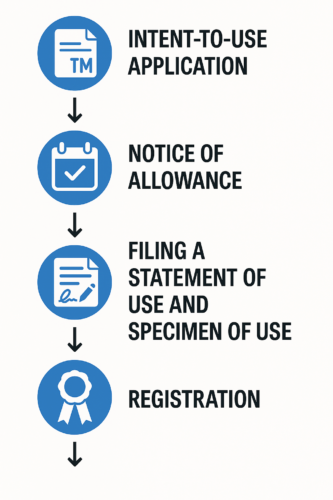
An "intent to use" (ITU) trademark application can be a valuable first step in the trademark registration process. A business can secure priority in a brand name, logo, or slogan (the trademark) before the business establishes any sales under the trademark. An intent to use application allows applicants to secure a priority filing date while they prepare for product or service rollout. Many well-known companies in tech, fashion, and entertainment file ITU applications before launching brands. This proactive strategy helps secure rights during product development and marketing preparation.
For example, a startup planning to launch a new software service may file an ITU application with the mark associated with the intended software service. While finalizing beta testing and marketing materials, the trademark application is pending and the company can subsequently register the mark once it is in use in commerce.
An intent to use trademark application is a filing option under Section 1(b) of the Lanham Act that can be submitted to the United States Patent and Trademark Office (USPTO). An ITU application allows applicants to claim rights in a trademark or service mark before it is used in commerce. Instead of proving actual use at the time of filing, the applicant provides a sworn statement declaring a bona fide intent to use the mark in commerce in the near future.
An ITU application can be a valuable tool for startups, rebranding companies, and businesses launching new products or services. It allows the applicant to secure rights before there is public disclosure of the brand, and ensures that no one else can claim the mark after the filing date. This approach gives the applicant time to finalize branding, production, and marketing without third parties establishing earlier rights in the same or similar mark.
To file an intent to use application, the applicant must have a bona fide intent to use the applied-for mark in commerce. This means the intent must be in good faith and genuine, with current plans to carry out the provision of the goods or services under the applied-for mark. The USPTO and courts may require the applicant to provide evidence of this intent, such as business plans, product prototypes, or marketing research.
The requirement of a bona fide intent to use a trademark ensures that the trademark register reflects marks tied to genuine commercial activity rather than speculative or defensive filings. This policy protects the integrity of the registration system by preventing applicants from blocking others through unused placeholder applications intended to obstruct the lawful use of trademarks in commerce. It also aligns with the constitutional basis for trademark law under the Commerce Clause, which requires a real intent to use the mark in commerce.
If a legal conflict develops later (e.g., a third party challenges the application), having sufficient evidence of bona fide intent becomes crucial. If the party challenging the validity of the ITU application filing can show that there was no bona fide intent to use the applied-for mark at the time the intent to use application was filed, the resulting trademark registration may be invalidated void ab initio and possibly fraud on the trademark office.
Filing a trademark application on an intent to use (ITU) basis provides significant strategic advantages for businesses and brand owners preparing to launch new products or services. One of the primary benefits is the ability to secure an earlier application filing date. The filing date establishes priority, which can be crucial if a legal conflict develops or if another party later attempts to register a confusingly similar mark. By locking in that earlier date, the applicant gains a competitive edge in potential disputes. In addition, an ITU application serves as a powerful brand reservation tool. It signals to the marketplace that the applicant has laid claim to the mark, discouraging others from using or seeking to register identical or similar marks. This early filing can prevent costly conflicts down the road. Furthermore, the ITU process provides flexibility, allowing applicants time to develop their brand identity, marketing materials, and distribution plans before proving actual use in commerce.
https://sierraiplaw.com/wp-content/uploads/2025/06/Infographic-intent-to-use-e1750058023850.png
The intent to use (ITU) application process is very similar to standard use-based trademark application under Section 1(a) of the Lanham Act, but with some important distinctions. When completing the application form, the applicant must designate the application under the “intent to use” basis and include a sworn statement affirming a bona fide intent to use the mark in commerce. The applicant must also clearly identify the goods and/or services with which the mark is intended to be used.
After submission, the application is assigned to a USPTO examining attorney. The examining attorney reviews the ITU application to ensure that it satisfies all legal requirements under the Lanham Act, including proper classification, clarity of the identified goods or services, and the absence of conflicting marks. If the application passes this examination without issue, it proceeds to publication in the Official Gazette. This public notice gives third parties an opportunity to oppose the mark’s registration if they believe it would cause them harm. If no opposition is filed, or if any opposition is resolved in the applicant’s favor, the USPTO issues a Notice of Allowance (NOA), signaling that the application has been preliminarily approved pending proof of actual use in commerce.
A Notice of Allowance (NOA) indicates that the intent to use (ITU) application has been preliminarily approved by the USPTO, but the mark is not yet registered. To proceed to a trademark registration, the applicant must prove actual use of the mark in commerce. This is done by filing a Statement of Use (SOU), which includes a verified statement affirming that the mark is currently in use, and a specimen of use showing the mark as used in connection with the identified goods or services.
The SOU must be filed within six months of the issuance of the NOA. If the applicant is not yet ready to demonstrate use within that initial six-month period, they may request an extension of time. The USPTO permits up to five such extension requests, each granting an additional six months, for a total allowable period of up to three years from the NOA date to file the SOU. Each extension request must be accompanied by the required fee and a continued declaration of the applicant’s good faith intention to use the mark.

If the applicant begins using the mark after filing the ITU application but before the Notice of Allowance is issued, they can file an Amendment to Allege Use instead of waiting to file the SOU. This amendment includes the same requirements as a SOU and, once accepted, shifts the basis of the application from intent to use to actual use.
An intent to use trademark application is a powerful tool for businesses seeking to protect their intellectual property before launching a new product or service. It allows applicants to claim a priority filing date while securing time to develop their brand.
With careful planning, an ITU application can help business owners obtain robust trademark protection with long-term value.
To ensure successful registration, applicants should file early to secure an earlier application filing date, maintain documentation proving bona fide intent, and begin using the mark in commerce at the earliest possible time so that registration can be achieved within the statutory timeframe of up to three years from the NOA.
If you are considering launching a business or brand, or you have other trademark matters with which you need assistance, contact our office for a free consultation.
© 2025 Sierra IP Law, PC. The information provided herein does not constitute legal advice, but merely conveys general information that may be beneficial to the public, and should not be viewed as a substitute for legal consultation in a particular case.

"Mark and William are stellar in the capabilities, work ethic, character, knowledge, responsiveness, and quality of work. Hubby and I are incredibly grateful for them as they've done a phenomenal job working tirelessly over a time span of at least five years on a series of patents for hubby. Grateful that Fresno has such amazing patent attorneys! They're second to none and they never disappoint. Thank you, Mark, William, and your entire team!!"
Linda Guzman

Sierra IP Law, PC - Patents, Trademarks & Copyrights
FRESNO
7030 N. Fruit Ave.
Suite 110
Fresno, CA 93711
(559) 436-3800 | phone
BAKERSFIELD
1925 G. Street
Bakersfield, CA 93301
(661) 200-7724 | phone
SAN LUIS OBISPO
956 Walnut Street, 2nd Floor
San Luis Obispo, CA 93401
(805) 275-0943 | phone
SACRAMENTO
180 Promenade Circle, Suite 300
Sacramento, CA 95834
(916) 209-8525 | phone
MODESTO
1300 10th St., Suite F.
Modesto, CA 95345
(209) 286-0069 | phone
SANTA BARBARA
414 Olive Street
Santa Barbara, CA 93101
(805) 275-0943 | phone
SAN MATEO
1650 Borel Place, Suite 216
San Mateo, CA, CA 94402
(650) 398-1644. | phone
STOCKTON
110 N. San Joaquin St., 2nd Floor
Stockton, CA 95202
(209) 286-0069 | phone
PORTLAND
425 NW 10th Ave., Suite 200
Portland, OR 97209
(503) 343-9983 | phone
TACOMA
1201 Pacific Avenue, Suite 600
Tacoma, WA 98402
(253) 345-1545 | phone
KENNEWICK
1030 N Center Pkwy Suite N196
Kennewick, WA 99336
(509) 255-3442 | phone
2023 Sierra IP Law, PC - Patents, Trademarks & Copyrights - All Rights Reserved - Sitemap Privacy Lawyer Fresno, CA - Trademark Lawyer Modesto CA - Patent Lawyer Bakersfield, CA - Trademark Lawyer Bakersfield, CA - Patent Lawyer San Luis Obispo, CA - Trademark Lawyer San Luis Obispo, CA - Trademark Infringement Lawyer Tacoma WA - Internet Lawyer Bakersfield, CA - Trademark Lawyer Sacramento, CA - Patent Lawyer Sacramento, CA - Trademark Infringement Lawyer Sacrament CA - Patent Lawyer Tacoma WA - Intellectual Property Lawyer Tacoma WA - Trademark lawyer Tacoma WA - Portland Patent Attorney - Santa Barbara Patent Attorney - Santa Barbara Trademark Attorney